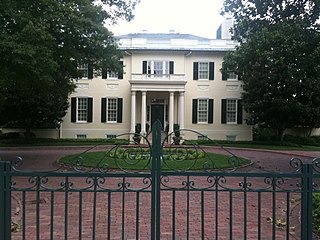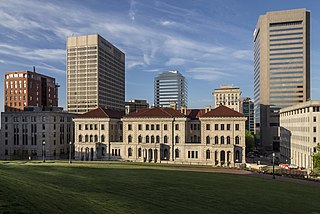
Richmond is the capital city of the Commonwealth of Virginia in the United States. It is the center of the Richmond Metropolitan Statistical Area (MSA) and the Greater Richmond Region. Richmond was incorporated in 1742 and has been an independent city since 1871. As of the 2010 census, the city's population was 204,214; in 2020, the population had grown to 226,610, making Richmond the fourth-most populous city in Virginia. The Richmond Metropolitan Area has a population of 1,260,029, the third-most populous metro in the state.

Franklin is a town in Pendleton County, West Virginia, United States. The population was 721 at the 2010 census. It is the county seat of Pendleton County. Franklin was established in 1794 and named for Francis Evick, an early settler.

The Appomattox Court House National Historical Park is a preserved 19th-century village in Appomattox County, Virginia. The village is famous for the site of the Battle of Appomattox Court House, and contains the house of Wilmer McLean, where the surrender of the Army of Northern Virginia under Robert E. Lee to Union commander Ulysses S. Grant took place on April 9, 1865, effectively ending the American Civil War. The McLean House was the site of the surrender conference, but the village itself is named for the presence nearby of what is now preserved as the Old Appomattox Court House.

Thomas Bahnson Stanley was an American politician, furniture manufacturer and Holstein cattle breeder. A Democrat and member of the Byrd Organization, Stanley served in a number of different political offices in Virginia, including as the 47th Speaker of the Virginia House of Delegates and as the Commonwealth's 57th Governor. He became known for his support of the Massive Resistance strategy to prevent school desegregation mandated by the United States Supreme Court's decisions in Brown v. Board of Education, and Virginia's attempt to circumvent those decisions was known as the Stanley Plan.

Byrd Park, also known as William Byrd Park, is a public park located in Richmond, Virginia, United States, north of the James River and adjacent to Maymont. The 200-acre (0.81 km2) park includes a mile-long trail with exercise stops, monuments, an amphitheatre, and three small lakes: Shields, Swan, and Boat Lake. Boat Lake has a lighted fountain at its center. Visitors can rent pedal boats there in season. The park includes tennis courts, Little League baseball fields, and a children's playground. The historic round house and Poplar Vale Cemetery are also located in the park. It is named after William Byrd II, whose family owned much of the area when Richmond was founded in 1737. The park was listed on the National Register of Historic Places in 2016.

The Fan is a district of Richmond, Virginia, so named because of the "fan" shape of the array of streets that extend west from Belvidere Street, on the eastern edge of Monroe Park, westward to Arthur Ashe Boulevard. However, the streets rapidly resemble a grid after they go through what is now Virginia Commonwealth University. The Fan is one of the easterly points of the city's West End section, and is bordered to the north by Broad Street and to the south by VA 195, although the Fan District Association considers the southern border to be the properties abutting the south side of Main Street. The western side is sometimes called the Upper Fan and the eastern side the Lower Fan, though confusingly the Uptown district is located near VCU in the Lower Fan. Many cafes and locally owned restaurants are located here, as well as historic Monument Avenue, a boulevard formerly featuring statuary of the Civil War's Confederate president and generals. The only current statue is a more modern one of tennis icon Arthur Ashe. Development of the Fan district was strongly influenced by the City Beautiful movement of the late 19th century.

Oregon Hill is a historic working-class neighborhood in Richmond, Virginia. Oregon Hill overlooks the James River and Belle Isle, and provides access to Hollywood Cemetery. Due to the neighborhood's proximity to the Monroe Park Campus of Virginia Commonwealth University, the neighborhood is sometimes referred to as a student quarter because of its high college student population.

Westover Plantation is a historic colonial tidewater plantation located on the north bank of the James River in Charles City County, Virginia. Established in c. 1730–1750, it is the homestead of the Byrd family of Virginia. State Route 5, a scenic byway, runs east–west to the north of the plantation, connecting the independent cities of Richmond and Williamsburg.

The James River and Kanawha Canal was a partially built canal in Virginia intended to facilitate shipments of passengers and freight by water between the western counties of Virginia and the coast. Ultimately its towpath became the roadbed for a rail line following the same course.

The Virginia Governor's Mansion, better known as the Executive Mansion, is located in Richmond, Virginia, on Capitol Square and serves as the official residence of the governor of the Commonwealth of Virginia. Designed by Alexander Parris, it is the oldest occupied governor's mansion in the United States. It has served as the home of Virginia governors and their families since 1813. This mansion is both a Virginia and a National Historic Landmark, and has had a number of successive renovations and expansions during the 20th century.

C. E. Byrd High School, a Blue Ribbon School, is a high school in Shreveport, Louisiana, United States. In continuous operation since its establishment in 1925, C. E. Byrd is also the eighth-largest high school in the state of Louisiana as of February 2019. Byrd students come from its neighborhood or throughout the entire Caddo Parish school district through its selective math/science magnet program.

Shockoe Slip is a district in the downtown area of Richmond, Virginia. The name "slip" referred to a narrow passageway leading from Main Street to where goods were loaded and unloaded from the former James River and Kanawha Canal. The rough boundaries of Shockoe Slip include 14th Street, Main Street, Canal Street and 12th Street.

Mount Airy, near Warsaw in Richmond County, Virginia, constructed in 1764 for Colonel John Tayloe II, perhaps the richest Virginia planter of his generation, is a mid-Georgian plantation house, the first built in the manner of a neo-Palladian villa. John Ariss is the attributed architect and builder. Tayloe's daughter, Rebecca and her husband Francis Lightfoot Lee, one of the only pair of brothers to sign the Declaration of Independence are buried on the estate, as are many other Tayloes. Before the American Civil War, Mount Airy was a prominent racing horse stud farm, as well as the headquarters of about 10-12 separate but interdependent forced-labor plantations along the Rappahannock River. Mount Airy is listed on the National Register of Historic Places as a National Historic Landmark as well as on the Virginia Landmarks Register and is still privately owned by Tayloe's descendants.

This is a list of the National Register of Historic Places listings in Henrico County, Virginia.

The Clover Hill Tavern with its guest house and slave quarters are structures within the Appomattox Court House National Historical Park. They were registered in the National Park Service's database of Official Structures on October 15, 1966.

The Lewis F. Powell Jr. United States Courthouse, also known as the U.S. Post Office and Customhouse, is a historic custom house, post office and courthouse located in Richmond, Virginia. Originally constructed in 1858, it was for decades a courthouse for the United States District Court for the Eastern District of Virginia and the United States Court of Appeals for the Fourth Circuit. A new federal district courthouse opened in 2008, but the Powell Courthouse still houses the Fourth Circuit. The United States Congress renamed the building for Supreme Court justice Lewis F. Powell Jr., in 1993. It is listed on the National Register of Historic Places as U.S. Post Office and Customhouse.

Richmond Hill is an ecumenical fellowship, residence and urban retreat center. The St. John's Church Historic District in Richmond, Virginia includes several churches of various denominations, including this former Catholic convent and school which is a contributing property that continues to address the area's spiritual and educational needs.

The Laburnum Park Historic District is a national historic district located at Richmond, Virginia. The district encompasses 226 contributing buildings and 2 contributing structures located north of downtown Richmond. The primarily residential area developed starting in the early-20th century as one of the city's early "streetcar suburbs" and as home to several important local institutions. The buildings are in a variety of popular early-20th century architectural styles including Queen Anne and Colonial Revival. It was developed as neighborhood of middle-to-upper-class, single-family dwellings. Notable buildings include the Laburnum House (1908), Richmond Memorial Hospital (1954-1957), Richmond Memorial Hospital Nursing School (1960-1961), "The Hermitage" (1911), Laburnum Court (1919), Veritas School.

The Carillon Neighborhood Historic District encompasses a residential area of western Richmond, Virginia. It is located about 3 miles (4.8 km) west of downtown Richmond, and is roughly bounded on the north and west by the Powhite Expressway and the Downtown Expressway, on the south by the Kanawha Canal, and on the east by Byrd Park. Although this area has a residential history dating into the 19th century, its present architecture is reflective of its development first as a streetcar suburb, and then as a post-World War II housing development area.























